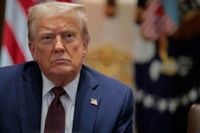American farmers, particularly those cultivating soybeans in the Midwest, are bracing for a new round of federal aid as the Trump administration prepares to unveil a substantial bailout package in response to the economic fallout from ongoing trade tensions with China. Treasury Secretary Scott Bessent confirmed on Thursday that the White House will announce details on Tuesday, October 7, 2025, promising what he described as "substantial support" for those hit hardest by the trade war’s aftershocks.
The sense of urgency is palpable. Since President Trump’s "Liberation Day" tariff regime took effect, China—the largest export market for American soybeans—has virtually halted all purchases of U.S. crops. According to The Wall Street Journal, this has left soybean farmers facing devastating losses, with Senator Chuck Grassley, himself a farmer, noting that "China has not bought a single one of Americans’ soybeans this year, and that’s why farmers are losing $2 per bushel." For many, this is not just a matter of business, but of survival.
President Trump has been vocal about his intention to use tariff revenues to support the nation’s agricultural sector. In a Truth Social post on October 1, 2025, he wrote, "The Soybean Farmers of our Country are being hurt because China is, for 'negotiating' reasons only, not buying. We've made so much money on Tariffs, that we are going to take a small portion of that money, and help our Farmers." The administration has collected billions of dollars in tariff revenue—funds initially earmarked to help reduce federal deficits—but is now considering redirecting a portion to provide direct relief to farmers.
Yet, the mechanics of this bailout remain uncertain. While the Department of Agriculture has already spent $8 billion sending checks to farmers affected by "increased input costs and falling commodity prices," as reported by The Wall Street Journal, officials are still working out how to structure the next phase of aid. The White House could announce between $10 billion and $14 billion in direct economic assistance, though some Republicans estimate the true need could reach as high as $35 billion to $50 billion, according to sources cited by Politico. The USDA’s Commodity Credit Corporation fund, previously tapped for $28 billion in farm aid during the earlier phase of the U.S.-China trade war, now has just $4 billion left. This shortfall has led officials to explore the possibility of supplementing payments with tariff receipts or other funding sources.
However, using tariff revenue for direct bailouts could ignite a fierce battle in Congress. While President Trump and his advisers, including Treasury Secretary Bessent and Agriculture Secretary Brooke Rollins, have discussed the plan in the Oval Office, any move to reallocate tariff funds would likely require legislative approval. This could set the stage for intense partisan wrangling, especially amidst broader debates over government spending. As Politico notes, GOP lawmakers are considering proposals to replenish the USDA fund, but Democrats are expected to push back, citing concerns over fiscal responsibility and the precedent such bailouts might set.
The timing of the aid rollout is further complicated by the ongoing government shutdown, which has shuttered large portions of the Agriculture Department. According to Politico, this has made it difficult to finalize estimates for the size of the first tranche of aid or to distribute funds quickly. Meanwhile, farmers continue to face mounting losses, with some Republicans in Congress urging immediate action. "Tariffs not only cause farmers to pay more for their inputs, but they have also seen tariffs reduce markets for U.S. farm products," Senator Grassley argued on the Senate floor. "Taking away tariffs on ... inputs and striking meaningful deals to open markets would send immediate signals" that the government stands with farmers, he said.
Internal tensions within the administration have also come to light. A photograph taken at the United Nations General Assembly revealed a group chat on Secretary Bessent’s phone, in which Agriculture Secretary Rollins expressed frustration over a recent bailout for Argentina. "I am getting more intel, but this is highly unfortunate. We bailed out Argentina yesterday and in return, the [Argentines] removed their export tariffs on grains, reducing their price to China at a time when we would normally be selling to China," Rollins wrote. "Soy prices are dropping further because of it. This gives China more leverage on us."
Senator Grassley echoed this sentiment on social media, questioning, "Why would USA help bail out Argentina while they take American soybean producers’ biggest market??? We [should] use leverage at every turn to help hurting farm economy. Family farmers [should] be top of mind in negotiations by representatives of USA."
Despite the controversy, Secretary Bessent defended the administration’s approach to Argentina, arguing that supporting the South American nation was crucial for broader geopolitical reasons. "America first doesn’t mean America alone," Bessent told CNBC. "Argentina is a beacon down there, and there’s a chance now for many other countries to come along … So, what you don’t want are these failed economic models." He praised Argentine President Meilei for "working against history" and doing "a fantastic job."
For many in the agricultural sector, these debates are more than theoretical. The loss of the Chinese market, compounded by competition from countries like Argentina, has left soybean prices in freefall and farm incomes under severe strain. The Department of Agriculture has yet to respond to requests for comment on the specifics of the upcoming aid package, but the anticipation is high. As Secretary Bessent put it, "You should expect some news on Tuesday on substantial support for our farmers, especially the soybean farmers — they have had President Trump's back and we have their back."
With the announcement looming, all eyes are on the White House to see whether the proposed bailout will be enough to stabilize the farm economy—or if deeper structural changes to trade policy will be required to restore American agriculture’s footing in the global market. For now, the nation’s farmers are left waiting, hoping that this latest round of promises will translate into meaningful relief.





